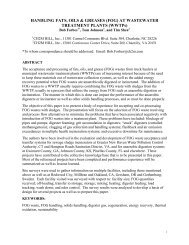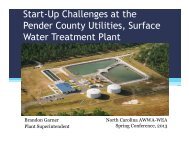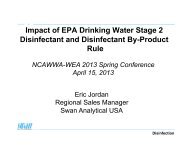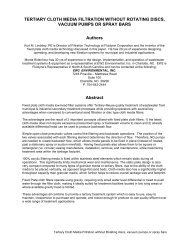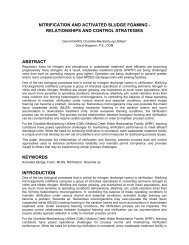GRIT HAPPENS â YOU DON'T KNOW WHAT YOU ARE MISSING
GRIT HAPPENS â YOU DON'T KNOW WHAT YOU ARE MISSING
GRIT HAPPENS â YOU DON'T KNOW WHAT YOU ARE MISSING
- No tags were found...
You also want an ePaper? Increase the reach of your titles
YUMPU automatically turns print PDFs into web optimized ePapers that Google loves.
they will deposit throughout the process where conditions are conducive to settling, the grit thenconsumes tank volume and reduces process capacity.Processes such as fine bubble aeration basins, primary clarifiers and digesters are susceptible to gritdeposition. The reduction in processing capacity can affect the plant’s ability to achieve process designgoals such as; reducing methane production, reducing volatile solids reduction or impeding mixingeffectiveness in digesters (Massart, O’Kelley & Neun, 2010); or increasing operational costs, such ashorsepower requirements in aeration basins (Herrick, 2009).At most treatment plants, grit accumulations typically happen gradually and continuously. It often goesunnoticed until a process is completely overwhelmed and needs to be shut down to manually remove thedeposited grit, which is a labor intensive and costly operation. In some instances, when a process mustbe taken off-line, the flow to the entire process train must be diverted. This requires building excess plantcapacity to use as grit storage which can significantly increase the size, cost and footprint of the plant.<strong>GRIT</strong> COLLECTION TECHNOLOGIESMost headworks grit collection processes are sedimentary processes and therefore knowing the natureand characteristics of the grit arriving at the treatment plant can be critical for design. In terms of design,the most important criteria to be considered are an accurate size distribution and particle settling velocity.Gravity Sedimentation Basins, Aerated Grit Basins and Forced Vortex Grit Basins are the three commontypes of grit removal systems. In each of these processes gravity is the predominant force field. ForcedVortex Grit Basins take advantage of centrifugal and other rotary derived forces to promote grit removal,but these forces are at most equal to, and in most cases significantly lower than gravitational forces.Therefore knowing the settling velocity of the incoming grit is critical to properly design the process.Utilizing both size distribution and settling velocity distribution enables the designer to establish a removalefficiency target and determine the design cut point particle. If size distribution alone is considered theremoval results can be significantly different than anticipated. Many grit removal systems do not performas designed because the settling velocity of the grit was over estimated.Once collected the grit must be washed and dewatered in order to produce a clean dry product for landfill.All three steps of the grit removal system, collection, washing and dewatering, must be as effective as thecollection device otherwise the overall system efficiency will suffer. A system approach to design is themost effective. It is not uncommon to see a sufficient volume of grit captured in the collection step, only tolose collected material back to the process in the washing and dewatering steps. A grit study performedat Fox Lake, Illinois showed that while the aerated grit basin removed 58% of total grit volume enteringthe plant, the cyclone/screw classifier washing and dewatering equipment only retained 17% of what itreceived (Griffiths, 2004, Boldt 2005). The loss of grit in the washing and dewatering step reduced thesystem’s overall efficiency to only 10%.<strong>GRIT</strong> CHARACTERIZATIONOne reason that conventional grit removal systems often fail to achieve effective removal is due to thesize and settling velocity of grit being over estimated during design. This occurs when generic designcriteria are used instead of developing a set of grit characteristics specific to the wastewater flow beingtreated. Generic design criteria often assume that each grit particle is a sphere settling in laminarconditions in clean water. Grit behavior in wastewater is a complex phenomenon governed by numerousfactors such as size, specific gravity, shape, tendency for agglomeration with other wastewaterconstituents and environmental factors such as wet weather influences.SizeThe conventional design criterion of 210 µm removal has allowed passage of large quantities of grit intowastewater treatment plants. Figure 1 shows the size distribution of grit found from onsite studies at anumber of plants around the country (Osei and Andoh, 2008). Considering size alone it can be seen inthe below chart that in many plants 50% of the incoming grit is smaller than the conventional design cutpoint of 210 µm. Therefore, based solely on size distribution, by design, grit removal systems often misshalf of the incoming grit. Modifying design criteria to remove 90% of the incoming grit requires changingthe design cut point to somewhere between 75-150 µm, depending on the gradation of the native grit.Grit Happens – You Don’t Know What You Are Missing




